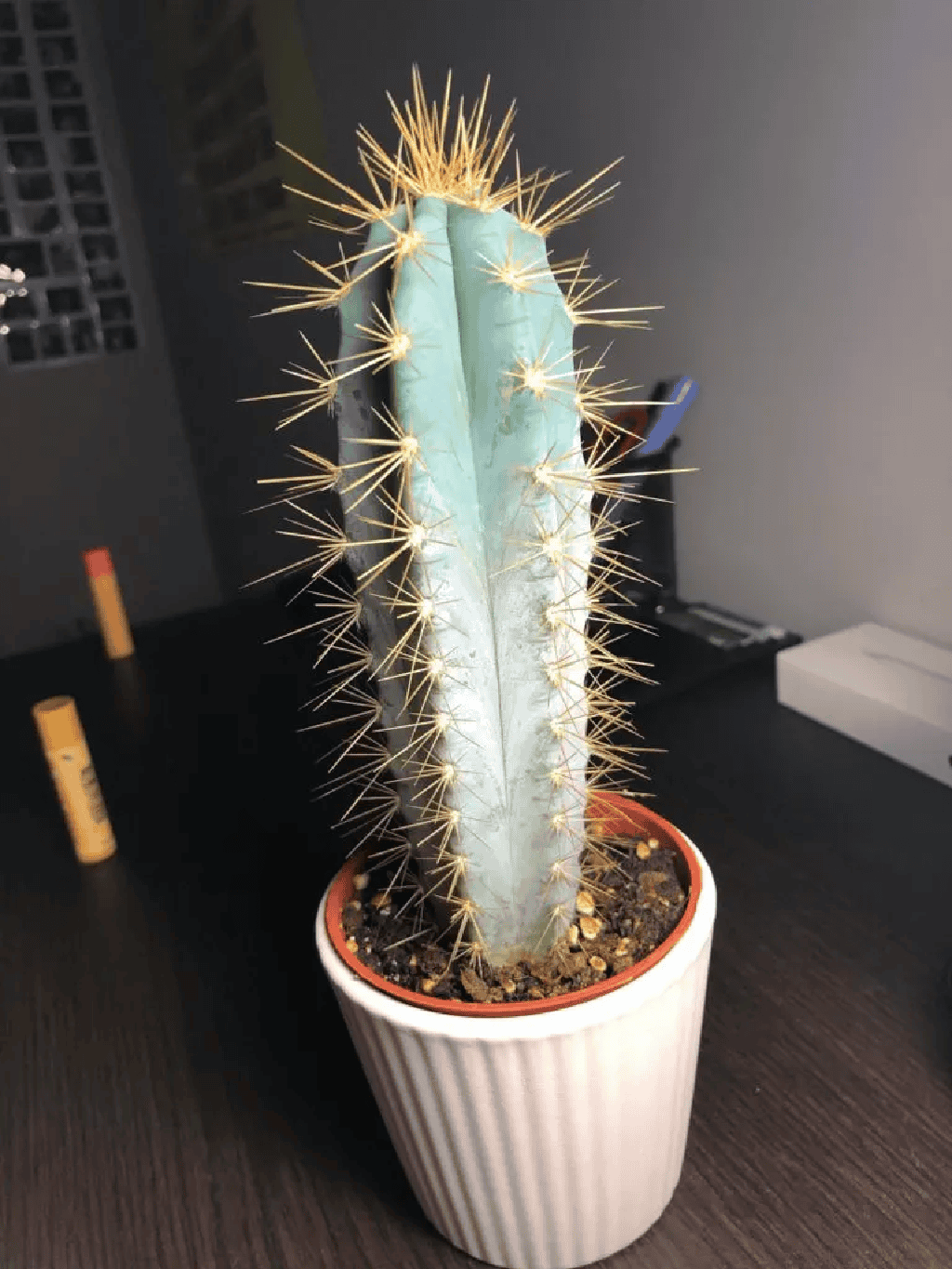Cactus Turning White? Here are 4 Common Reasons Why

If you’re sitting at home admiring your beautiful cactus plant and notice ‘my cactus is turning white’, then it may be a cause for concern. A cactus turning white can be for a range of different reasons. In this article, I will be discussing all the common reasons a cactus will turn white.
Cacti are renowned for being low maintenance and easy to care for. They are a desert plant, so enjoy warm, sunny spots around the home and can easily miss a watering or two! However, this doesn’t mean that having a cactus houseplant doesn’t come with occasional problems.
One of these common cactus problems can be that you notice it becoming pale, discolored, or turning white.
Why Is My Cactus Turning White?
If you have landed on this page, then chances are you’re wondering why your cactus is turning white. Typically, there are 4 common reasons why a cactus turns white, pale, or discolored.
Sunburn
The first reason for your cactus turning white could be due to sunburn. I know, you’re thinking what? Sunburn? But aren’t cactus desert plants? YES. Cactus are desert plants and are very tolerable to the sun. However, just like all succulent types, they are susceptible to a bit of sunburn.
If you have your cacti planted outside, or on a window sill, and you are not rotating your cacti, then you will start to notice that the skin begins to bleach out and turn a shade of white. Although plants can survive in harsh, extreme climates, this is actually a very common problem.
If you have your indoor cactus on a window sill by a south-facing window, then you will want to make sure that you are frequently rotating it to avoid any potential sun damage. Outdoor cacti will usually develop a certain tolerance to the sun.
But if you are moving your cactus, you should mark the south side of the plant before you replant so you know how to orient it. If you plant it in a different direction to before, then the side that hasn’t been receiving the south-facing sun is much more likely to become burnt and turn white, as this side would not have built up a tolerance.
Etiolation
Alternatively, if your cactus has been receiving too little sunlight, then it can cause something called etiolation. This is when the exclusion of light causes your plant to go white or pale. Another common characteristic, and one that you might notice first, is that your cactus becomes stretched, leggy, or elongated. The reason for this is because it is stretching towards the nearest source of light.
Etiolation is a common problem among all plant types, including succulent etiolation.
When a cactus is turning white due to etiolation, then it essentially means that it is producing insufficient chlorophyll (the component that is responsible for the green color of leaves and stems). This is called chlorosis and means that the cactus has little ability to complete photosynthesis – a vital part of any healthy plant cycle.
If you think your cactus turning white is due to etiolation, then you should immediately move it to a brighter spot. Typically, you will be able to tell by the growth pattern of your cactus. Unfortunately, the effects of etiolation are irreversible, but are mainly aesthetic and won’t cause any real harm to your cactus. If anything, a pale, stretched cactus can look quirky and unique!
| Learn more on why a cactus is turning black, |
Pests
The word we all hate to hear. PESTS. Particularly mealybugs. If you notice your cactus turning white, then you will want to check that you don’t have an infestation under your hands. Mealybugs are teeny tiny little pests that like to work in colonies.
They are white or cream in color, and because they gather in groups, it could make it look like your cactus is turning white. Alternatively, they could even be mistaken for a bit of dust and have the look of a cottony patch.
If you have a mealybug infestation, then you will want to work on eliminating them immediately. The first thing you should do is move your cactus away from any other houseplant, as they can spread like wildfire!
Mealybugs love clinging onto the tissues of your cacti and will suck all of the sap out of the stems. This can leave you with a droopy, floppy cactus.
The most effective mealybug treatment is a 70% or less solution of isopropyl (rubbing alcohol). Make sure you dilute in water and fill up a spray bottle. Make sure you spray your cactus plant all over and get in all the nooks and crannies, as this is where the bugs like to hang out.
Often one treatment will work. If not, then you will notice the mealybugs reappear in a few days, and you can do the treatment again and again until they eventually go away forever.
Cacti that are particularly susceptible to mealybugs are bunny ear cactus and barrel cactus.
Temperature trauma
The final most common cause of a cactus turning white is temperature trauma! Cacti are, for the most part, desert plants and thrive in a warm, sunny environment. If a cactus is exposed to freezing temperatures for even just a few hours, then damage can be done.
The temperature trauma will first be noticeable in the thinnest areas, such as the ridges. Damage depends on how long your cactus plant was exposed to freezing temperatures, but you will first notice it turns a white or pale yellow color. This will then eventually turn black or brown, depending on the severity of the damage.
If only exposed to the cold for a few hours, then the damage is most likely to be aesthetic and won’t cause any real harm to a cactus. However, if the plant is consistently exposed to freezing temperatures, then it will eventually die.
If you have an outdoor cactus and you live in an area where the temperature drastically drops during the winter and fall, you should ideally be moving your cactus indoors for this period.
Desert Gem Cactus Turning White

One of the most common queries I get is people asking me why their desert gem cactus is turning white.
The answer is simple. Desert gem cactus are bright, wonderful houseplants, but they have been artificially dyed. The base of the plant will usually be its natural green, and a particular process has been applied to make them turn brilliant colors on top.
If you notice your desert gem cactus turning white, then it will be because of new growth. When a desert gem cacti experiences growth, then the spines will be white. To preserve the color of your desert gem, then you can cut the new spines off.
| Also read: Why is My Cactus Squishy?. |
Cactus Turning White – The Last Word!
I hope you have enjoyed this article and found the advice you were looking for. Cactus turning white, pale, or discolored is a common problem for many succulent types.
To recap, a cactus turning white usually is due to one of these 4 reasons:
- Sunburn
- Etiolation
- Pests
- Temperature trauma
I also briefly discussed the reasons why a desert gem cactus would turn white and how this is usually down to new growth and is nothing to worry about.
If you have any other questions, then feel free to leave a comment, and I’ll get back to you as soon as possible!






